Star Wars Episode II: Attack of the Clones (2002)
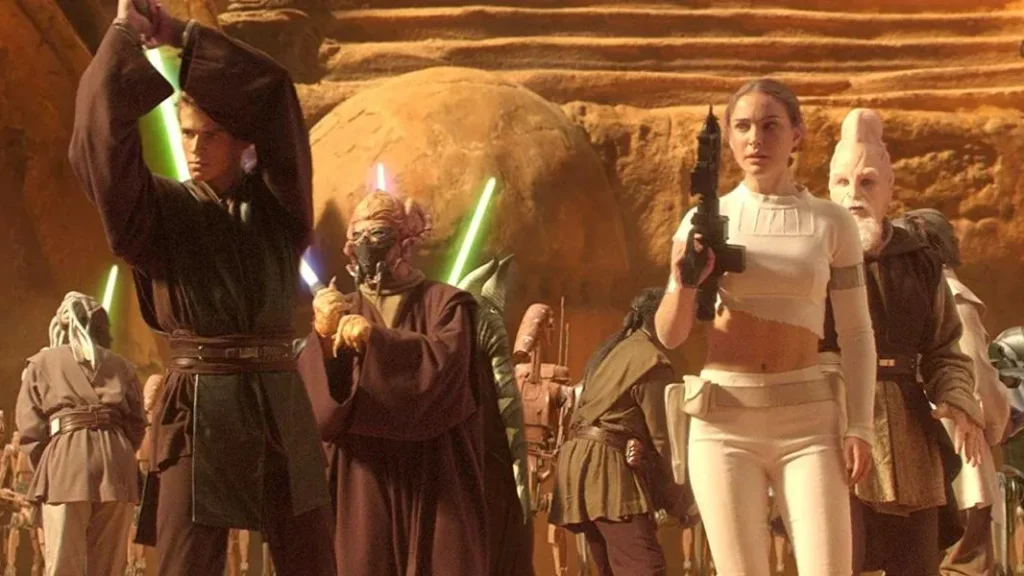
DIRECTOR: George Lucas
CAST: Ewan McGregor, Hayden Christensen, Natalie Portman, Samuel L. Jackson, Christopher Lee, Ian McDiarmid, Temuera Morrison, Frank Oz (voice)
REVIEW:
Attack of the Clones, George Lucas’ second installment in his Star Wars prequel trilogy, falls into the “middle chapter” syndrome that Empire Strikes Back managed to avoid, feeling less like a satisfactory stand-alone story unto itself and more like a bridge between The Phantom Menace and what would become Revenge of the Sith (eventually supplemented by the seven-season animated Clone Wars series which does a lot of expanding and plugging what happens in between). Part of why Clones falls into the pitfall that Empire avoided is simply that Empire was a stronger, more accomplished motion picture. Clones evidences, and—and in at least one plotline—magnifies some of the flaws of Phantom Menace: an uneven pace, stiff performances, and clunky dialogue. It all eventually culminates in an epic battle royale, but it takes a lot of tedium to get there.
We pick up approximately ten years after the events of The Phantom Menace. When the former Queen-turned-Senator Padme Amidala (Natalie Portman) survives an assassination attempt, Jedi Master Obi-Wan Kenobi (Ewan McGregor) and his grown apprentice Anakin Skywalker (Hayden Christensen) are assigned to protect her, but this only puts Anakin back in the orbit of the woman he’s been infatuated with since he was a child. After a second attempt is made on the Senator’s life, Anakin takes Padme to Naboo for some alone time—what could go wrong there?—while Obi-Wan pursues the mysterious bounty hunter Jango Fett (Temuera Morrison) across the galaxy. His investigation will eventually uncover a massive clone army being built for the Republic, and a secessionist plot spearheaded by the former Jedi Count Dooku (Christopher Lee) that will lead to civil war.
Compared to The Phantom Menace, which was too often aggressively marketed toward children, Attack of the Clones has a more somber tone. The much-maligned Jar Jar Binks (Ahmed Best) returns, but his screentime has been drastically reduced. There’s no alien fart jokes or precocious children running around blowing up battleships. In fact, the only overt bit of juvenile silliness involves C-3PO (Anthony Daniels) and R2-D2’s (Kenny Baker) bumbling antics in the droid factory. C-3PO’s pun-riddled dialogue is cringe-worthy. Alas, while Phantom Menace at least had a breezy pace for the most part, Clones is unevenly-paced and at times laborious (most egregiously during Anakin and Padme’s “love scenes”). We open with a literal bang, and not too long after that we get an eye-popping chase through the busy skyways of Coruscant, but after that there’s a lot of down time, broken up only by a hand-to-hand tussle between Obi-Wan and Jango Fett and a later pursuit through an asteroid field. Things pick up for the climax battle royale, which is essentially one extended action setpiece, first tossing our heroes into a sci-fi Colosseum pitted against exotic beasts, then giving us the sight of dozens of Jedi in action for the first time in the franchise’s history, then an even bigger battle royale between Republic forces and the Separatist droid army, and culminating in a three-way duel between Obi-Wan/Anakin and Count Dooku that’s followed by giving us another sight we’ve never seen before…Yoda (Frank Oz) drawing a lightsaber. Important things happen during all the down time in between—Obi-Wan’s investigation, the revelations of the clone army and the Separatist plot, and Anakin’s first real taste of darkness—but there’s too much exposition with too little payoff.
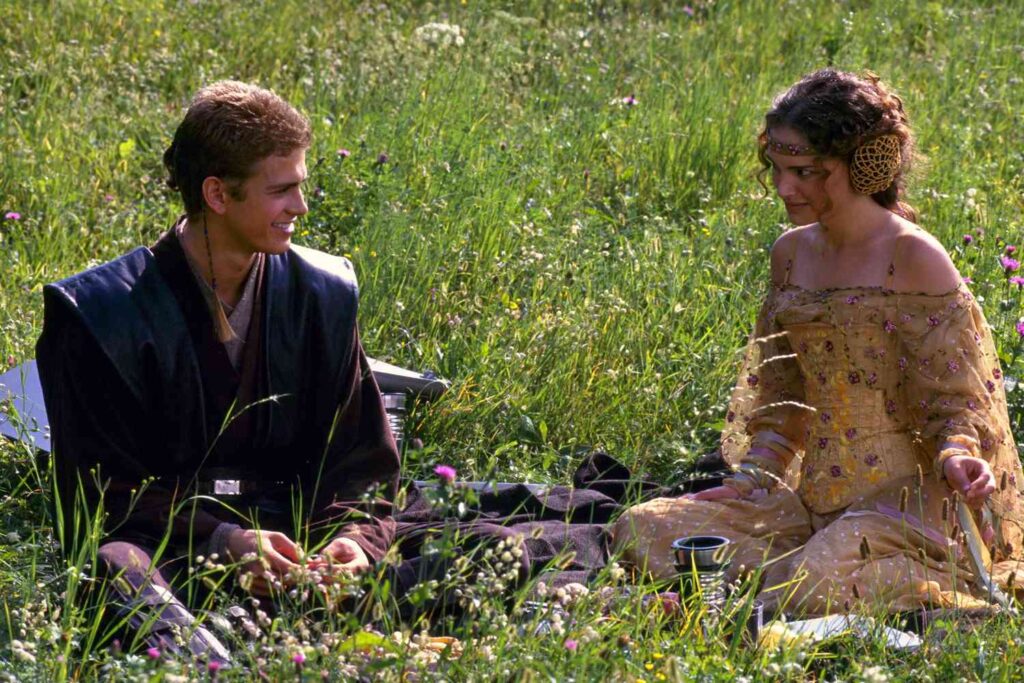
The forbidden romance between Anakin and Padme is a good idea in theory, but irreparably damaged in execution. To say that Natalie Portman and Hayden Christensen’s chemistry (or lack thereof) doesn’t set the screen on fire is an understatement, and the dialogue is awful: not just bad, but embarrassingly bad. Consider this sample: “I’m haunted by the kiss you should never have given me, hoping that kiss will not become a scar.” Huh? It’s also the first time I’ve ever heard sand used as an awkward flirting segue. Never has George Lucas’ dialogue weakness or his poor grasp on how to coax performances out of actors been so utterly fatal. The movie would have us believe they’re being swept up in a forbidden passion neither of them can control, but what we actually see onscreen is two actors sitting or standing around in awkwardly stagey choreography, reciting bad Harlequin romance dialogue with stilted line deliveries. The whole “love story” between Anakin and Padme feels forced and unconvincing. Just look back at how much more natural the snappy banter between Han and Leia felt in Empire Strikes Back, and imagine how much more effective this “love story” might have been if Lucas had ever actually allowed Anakin and Padme to talk to each other like real people.
Lucas also continues to make poor choices in his characterization of Anakin. In Phantom Menace he was a precocious child. Here, he’s an angsty, pouty, surly teenager who throws whiny temper tantrums and whose infatuation with Padme borders on creepiness. Where’s the dashing hero we’ve previously been led to expect? All too rarely does Christensen’s Anakin come across like someone the ostensibly level-headed and sensible Padme would even want around her, let alone fall desperately in love with (the later Clone Wars animated series did some damage control with a more heroic and more mature characterization of Anakin, but tie-in supplemental material shouldn’t have to do a movie’s work for it). At times, Lucas also shows a hazy grasp of interpersonal relationships (the ostensible passionate humanitarian Padme’s reaction to Anakin’s confession to basically committing mass murder is a bit lacking).
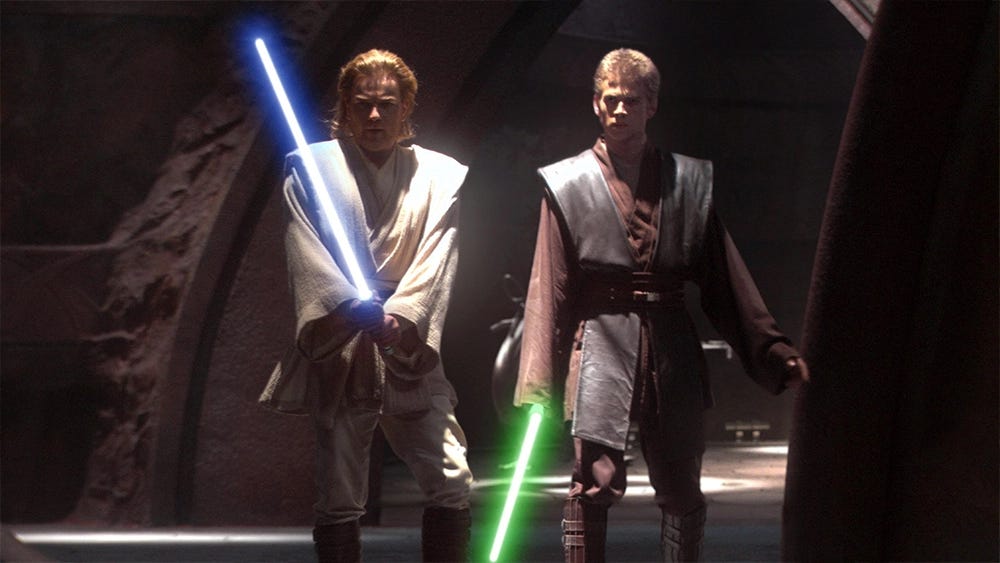
With so much of Anakin and Padme’s “love story” being awkwardly-staged tedium, Obi-Wan’s investigation is the strongest plot thread, but the movie’s narrative structure is awkward. Christopher Lee’s Count Dooku is the “main” villain this time around, but he doesn’t show up until late in the movie, and his motivations are undercooked. As before, Lucas takes us to some new worlds (the ocean planet Kamino, and the droid factories of Geonosis where the climax takes place) as well as revisiting some old ones (we return to Coruscant, Naboo, and Tatooine), but somehow the movie isn’t as visually arresting as what we expect from a Star Wars movie. At least Phantom Menace was bright and colorful and visually dazzling. There are some striking sights in Attack of the Clones, to be sure—the aerial chase through Coruscant, the towering, graceful Kaminoans, the sci-fi Colosseum—but somehow the images don’t “pop” the way we’ve come to expect. There’s a certain oddly drab and murky look to the movie, as if some desaturating filter has been placed across the screen. Even Naboo doesn’t look as vivid as it did last time.
Clones also suffers from the same weaknesses in dialogue and guiding actors that Lucas evidenced in Phantom. Scenes feel stagey and oddly lifeless, with actors sitting or standing around in elaborate costumes and awkwardly stagey choreography, stiffly reciting clunky exposition in stilted line deliveries. There’s little of the sense of spark or spontaneity of A New Hope (where, while the dialogue wasn’t Oscar-worthy and the acting wasn’t especially accomplished, the actors at least felt enthusiastic). Perhaps some of this is due to the prequel trilogy’s overreliance on green screen, with actors frequently forced to perform in front of barren green screens, their spectacular surroundings only to be added later by special effects technicians behind computer screens. Various actors have admitted to finding this uninspiring, not helped by Lucas’ seeming inability to coax livelier performances out of his cast (or even to notice when something isn’t working).
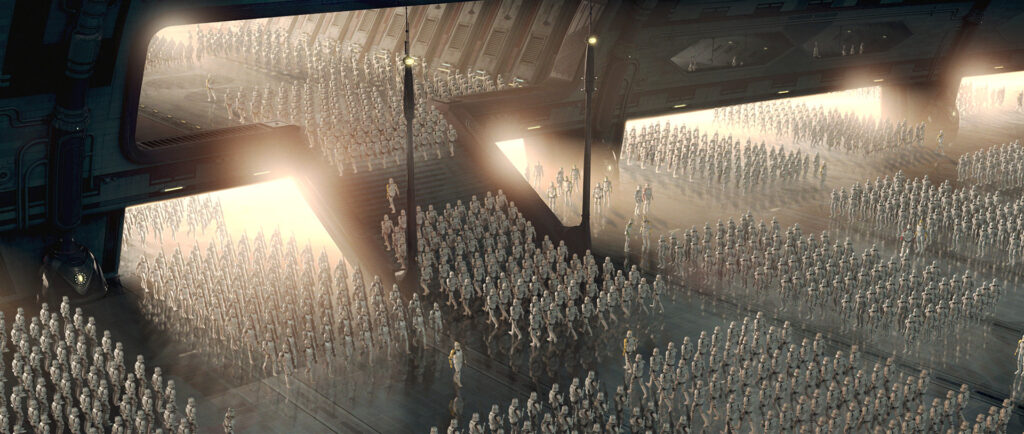
On the plus side, Clones serves up both nostalgic callbacks and foreshadowing, some of which is sure to give Star Wars fans chills. We return to the Lars family homestead from A New Hope and meet young versions of Luke’s Uncle Owen (Joel Edgerton) and Aunt Beru (Bonnie Piesse). We see a Jawa Sandcrawler and have another altercation with Tusken Raiders. The white-armored clone troopers are obvious forerunners to Imperial Stormtroopers, and certain ship designs begin to resemble Star Destroyers. A blueprint of the Death Star makes a cameo. We nudge events closer to where they were in the original trilogy, with Supreme Chancellor Palpatine (Ian McDiarmid) being granted emergency powers. His increasingly decrepit appearance nudges him closer to the shriveled creature under the hood we know from Return of the Jedi (sharp-eyed viewers may notice he’s now also got his red-costumed bodyguards). Senator Bail Organa (Jimmy Smits), Princess Leia’s future adoptive father, shows up, although his walk-on role is basically a cameo. The movie spends quite a bit of time on the subplot of bounty hunter Jango Fett and his son Boba (Daniel Logan)…arguably more backstory than the minor character of Boba Fett needed. Most significantly, we see the origins and opening salvos of the Clone Wars which were only mentioned in passing in one line of dialogue in A New Hope. John William comes up with a new, grandiose “love” theme, and lets his iconic “Imperial March” play in one of the closing scenes. Lucas’ foreshadowing occasionally gets too cute for its own good; Obi-Wan’s ham-handed “why do I feel like you’re going to be the death of me?” snark to Anakin gets an eyeroll.
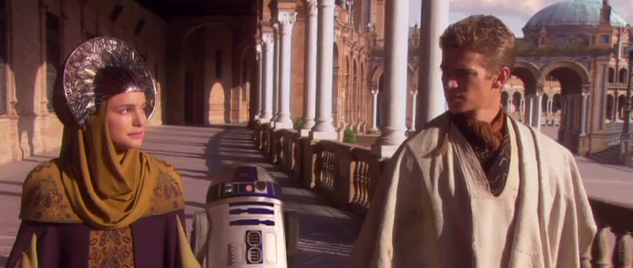
As usual, the acting is undistinguished. Hayden Christensen replaces the almost universally-panned Jake Lloyd in the pivotal role of Anakin Skywalker, but the bad news is that Christensen isn’t appreciably much better. He looks the part well enough, and he moves great with a lightsaber (Christensen’s physical dueling scenes are his most convincing), but his line deliveries are often stilted and wooden, not helped by odd inflections and an accent that sounds like it wavers between surfer dude and vaguely pseudo-British. Considering Natalie Portman, who’s shown substantial acting abilities when not trapped in the vortex of Lucas’ dialogue and direction, isn’t all that much better, perhaps it’s unfair to entirely blame Christensen. Ewan McGregor, now sporting a beard and adopting a more noticeable echo of Alec Guinness’ mannerisms and speaking cadence, is more steady, but he’s also not saddled with cringe-worthy “romantic” dialogue. Samuel L. Jackson gets to get up off his Jedi Council seat and get into the action in the climax, while Ian McDiarmid is underused (we get only one scene of him and Christensen together). Pernilla August makes a reappearance as Anakin’s mother, but her role is a thankless cameo. Christopher Lee, playing another secondary villain in another franchise in the same year as The Lord of the Rings: The Two Towers, strides through with his dignity unscathed, though given how much B-movie garbage he’s survived, it’s hard to imagine Lee ever not being dignified. Count Dooku doesn’t get a lot of screentime and doesn’t even show up until a late hour, and doesn’t have as strong of a presence as Lord of the Rings‘ Saruman.
Perhaps the most frustrating thing about Attack of the Clones is that, in its underlying mystery, its convoluted political intrigue, and even its forbidden romance, there’s a better version of the story trapped in here somewhere trying to get out, making one long for the days of Empire Strikes Back when Lucas was still willing to collaborate with other directors and screenwriters who could fine-tune his vision instead of trying to do everything himself (for the prequel trilogy, Lucas wears three hats as writer, director, and producer, leaving basically no one in a position to tell him no). Like its immediate predecessor, Attack of the Clones is a mixed bag, with a lot of clunky tedium to sift through in between the good stuff. In fact, in a couple of ways it’s arguably worse than The Phantom Menace. The pacing is more uneven, and at times the bad acting/dialogue is more egregious. Ultimately, it feels like little more than a stopgap, helping bridge some gaps between The Phantom Menace and Revenge of the Sith (though some of those gaps would only be bridged by the supplemental tie-in animated Clone Wars series). Empire Strikes Back managed to defy middle chapter syndrome, but Attack of the Clones falls into it.
* * 1/2